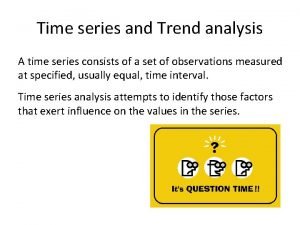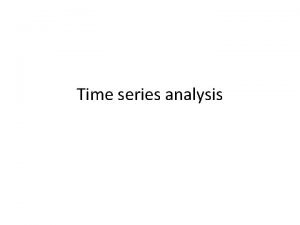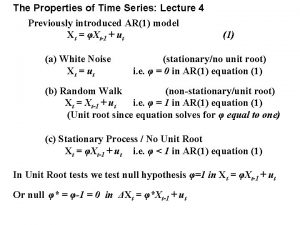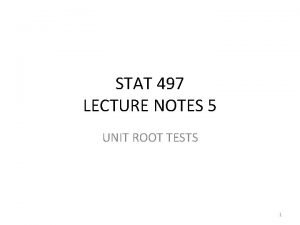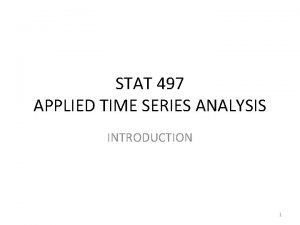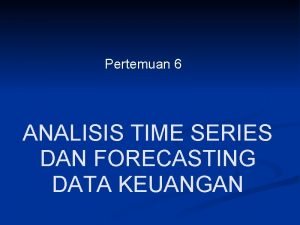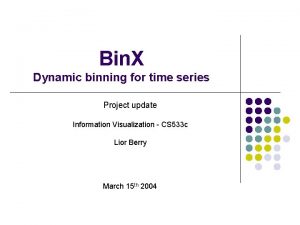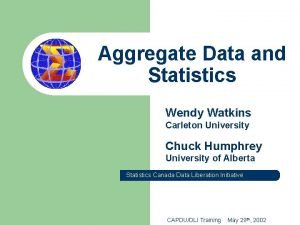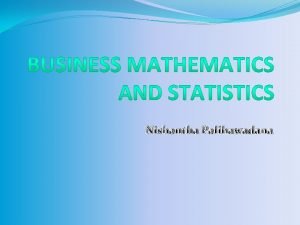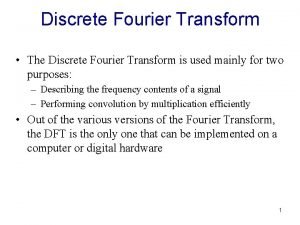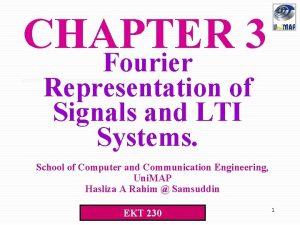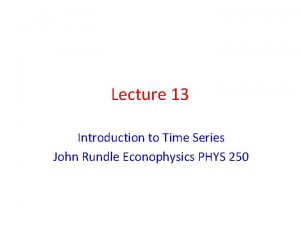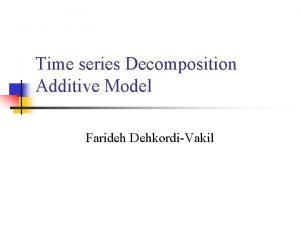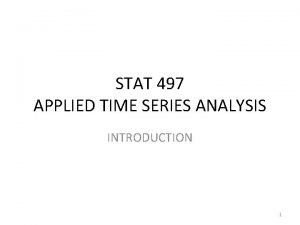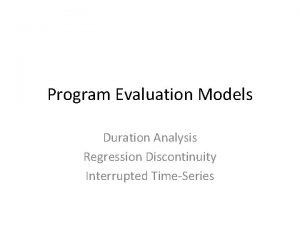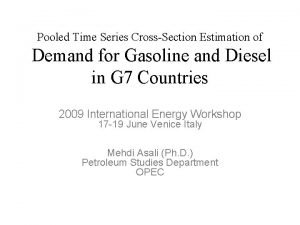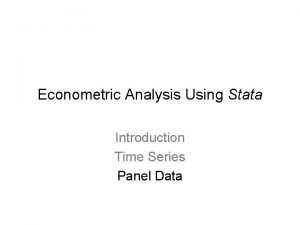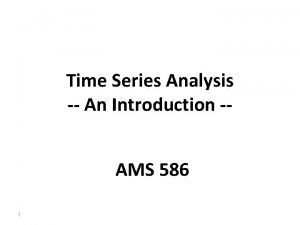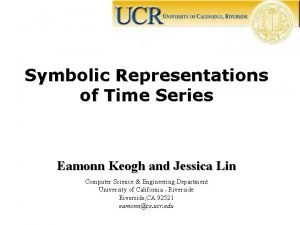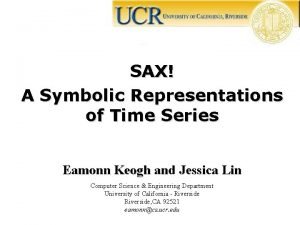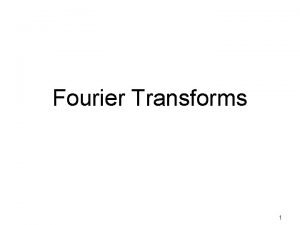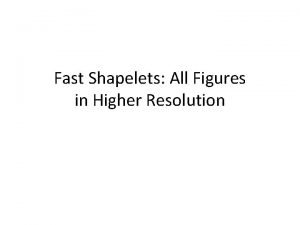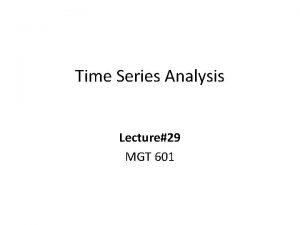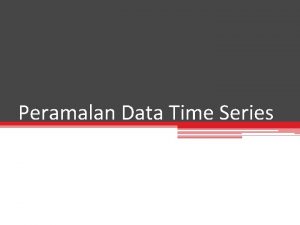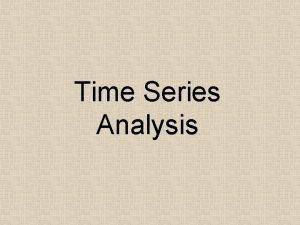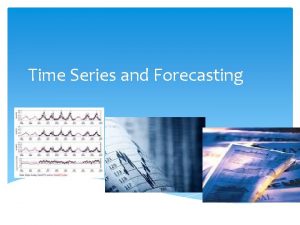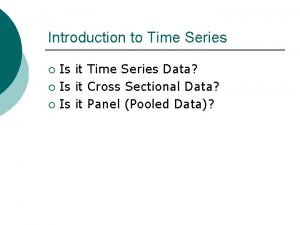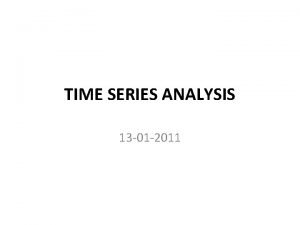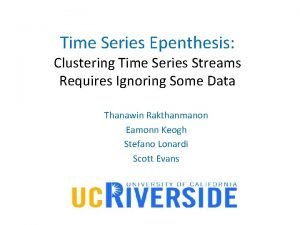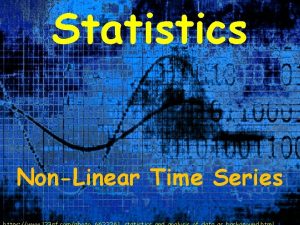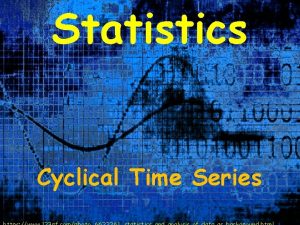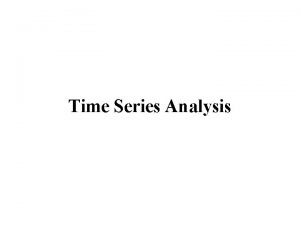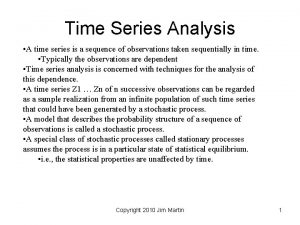Series 1 6 Series 2 Series 3 Time








































- Slides: 40

Series 1 6 Series 2 Series 3 Time Value of Money 5 4 $ 3 % n 2 1 0 Category 1 $$$ MBAmaterials Category 2 Category 3 Category 4

MBAmaterials What is Time value of money? • Worth of a rupee received today is different from the worth of rupee to be received in future. • We say that money has a time value because that money can be invested with the expectation of earning a positive rate of return 2

MBAmaterials Time lines visualize the what's happening in particular point of time Periods 0 5% 1 2 3 Cash PV= $100 FV=? 0 to 1 , 1 to 2 and 2 to 3 are time interval, time 0 is today , and it is beginning of the period; time 1 is period one from today; time 2 is period 2 from today and so on. 3

MBAmaterials Future Value A dollar in hand today is worth more than a dollar to be received in the future. Because , if you had it now, you could invest it, earn interest and end up with more dollar in future. For e. g. if you plan to deposit $100 in a bank that pays a guaranteed 5% interest each year. How much would you have at the end of year 3? 4

MBAmaterials Step-by-Step Approach • In this approach time line is used to find future value Time 0 Amount of beginning period $100 5% 1 $105. 00 2 $110. 25 3 $115. 50 At beginning, Present value (PV)= 100, time (t)= 0 , interest rate (I) = 5% multiply the initial amount, and each succeeding amount by (1+I) i. e. (1+ 0. 05= 1. 05) Amount of interest earned in first year is, $100(0. 05)=$5 , so the amount at the end of year 1 (t=1) is, FV 1 = PV+INT = PV +PV(I) = PV(1+I) = $100(1+ 0. 05) = $100(1. 05) = $105 5

MBAmaterials In second year, interest amount is $105(0. 05)= $5. 25 Now, FV 2 = FV 1(1+I) = PV(1+I)2 = 100(1. 05)2 = $110. 25 If N=3 , then we multiply PV by (1+I) three different times , FV 3 = FV 2(1+I) = PV(1+I)(1+I) = PV(1+I)3 = 100(1+0. 05)3 = $115. 76 Now we can define Future value as, FVn = PV(1+I)n --------- (1) 6

MBAmaterials Formula Approach We can apply the equation -1 above in this approach, in our example for third year, FV 3 = $100(1+0. 05)3 = $100(1. 05)3 = $115. 76 7

• MBAmaterials Present Value 8

MBAmaterials For example Suppose Us government bond promises to pay $ 115. 76 three years from now. If the interest rate on 3 –years government bond is 5% , how much is the bond worth today? Solution, Given, Future value (FV) = $115. 76 Interest Rate (I) = 5% No. of Periods (n) = 3 years Periods: Cash flow time line 0 1 PV =? ? 2 ? 3 $115. 76 9

• MBAmaterials 10

MBAmaterials How to find Interest Rate? FVn = PV(1+I)n The equation above has 4 variables, if we know three of them we can solve one. If we know PV, I and n , we can solve for FV , now suppose we know PV, FV and n , we need to find I. For example, a security has cost of $100 and that it will return $150 after 10 years. What is interest rate? Solution, Given , Present value (PV) = $100 Future Value (FV) = $150 No. of Years (n) = 10 years Interest Rate (I) = ? 11

MBAmaterials From equation, FVn = PV(1+I)n $150 = $100(1+I)10 $150/$100 = (1+I)10 = 1. 5 (1+I) = 1. 5(1/10) (1+I) = 1. 0414 I = 1. 0414 – 1 = 4. 14% 12

• MBAmaterials How to Find Number of Years? We sometimes need to know how long it will take to accumulate a required sum of money. For example, How long would it take $1000 to be double if it were invested in a bank that pays 6% per year? Solution, Given, Present value (PV) = $1000 Future Value (FV) = $2000 Interest rate (I) No. of Years = 6% p. a. (n) = ? 13

MBAmaterials from equation 1 FVn = PV(1+I)n $2000 = $1000(1+0. 06)n $2000/$1000 = (1+0. 06)n 2 = (1+0. 06)n By taking log both sides, we can find value of n, ln (2) = n [ln(1. 06)] n = ln (2)/ln(1. 06) n = 0. 6931/ 0. 0563 n = 11. 9 years Therefore, it takes $1000 about 11. 9 years to grow to $2000 if the interest rate is 6% 14

MBAmaterials Annuities • Many assets provides the series of cash inflow over time and many obligations like auto loan, students loan requires a series of payment. • If payments are equal and are made at fixed intervals , then the series is an annuity. • If the payment occur at the end of each period then it is ordinary annuity. For example: Student loan, Car loans etc. • Here is the time line for a $100, 3 -years, 5% ordinary annuity Periods Payments 0 5% 1 -$100 2 -$100 3 -$100 15

If the payments are made at the beginning of each period then it is annuity due. For example: life insurance premiums, rental payments for apartments MBAmaterials • here is the time line for annuity due periods 0 1 2 Payments -$100 3 16

MBAmaterials Future Value of an Ordinary Annuity An ordinary annuity is a series of equal payments, with all payments being made at the end of each and successive period. The future value of annuity due formula is used to calculate the ending value of a series of payments or cash flows where the first payment is received immediately. An example of an ordinary annuity is a series of rent or lease payments. For example, if we deposit $100 at the end of the each year for 3 years and earn 5% per year. What is the future value? Payment amount (PMT) = $100 Interest Rate 5% Number of periods (I) = (n) = 3 17

Cash flow time line 0 1 -$100 2 -$100 3 MBAmaterials Periods: -$100. 00 -$105. 00 -$110. 25 -315. 25 As we can see from the time line diagram, with step by step approach, FVA = PMT(1+I)n-1 + PMT(1+I)n-2 + PMT(1+I)n-3 = $100(1. 05)2 + $100(1. 05)1 + $100(1. 05)0 = $315. 25 18

• MBAmaterials 19

• The present value calculation for an ordinary annuity is used to determine the total cost of an annuity if it were to be paid right now. • We discount each payment back to time 0, then sum those discounted values to find annuity’s present value MBAmaterials Present Value of an Ordinary Annuity For example, if we deposit $100 at the end of the each year for 3 years and earn 5% per year. What is the present value? Payment amount (PMT) = $100 Interest Rate 5% Number of periods (I) = (n) = 3 20

0 Cash flow time line 1 -$100 2 -$100 3 MBAmaterials Periods: -$100 $95. 24 $90. 70 $86. 38 $272. 32 As we can see from the time line diagram, with step by step approach, PVA = PMT/(1+I)1 + PMT/(1+I)2 + PMT/(1+I)3 = $100/(1. 05)1 + $100/(1. 05)2 + $100/(1. 05)3 = $272. 32 21

• MBAmaterials 22

• MBAmaterials Perpetuities 23

• MBAmaterials 24

• MBAmaterials Future value of an uneven cash flow stream Future value of uneven cash flow stream is the sum of the future value of each cash flow compounded to the end of the stream at required rate of return. It is calculated by using the following relationship: FVn = CF 1(1+i)n-1 + CF 2(1+i)n-2 + CF 3(1+i)n-3 +. . . + CFn(1+i)0 25

MBAmaterials • For instance, let us suppose a security provides the following stream of cash flows till its maturity in five years. End of year 1 2 3 4 5 Cash flow ($) 100 150 200 250 400 26

MBAmaterials In above future value calculation the first year end cash flow is compounded for four years the second year end cash flow is compounded for three years and so on. year Cash flows($) 10%FVIF FV($) 1 100 (1. 1)4 = 1. 4641 146. 41 2 150 (1. 1)3 = 1. 3310 199. 41 3 200 (1. 1)2=1. 2100 242. 00 4 250 1. 1)1 = 1. 1000 275. 00 5 FV OF UNEVEN CASH FLOW 400 (1. 1)0= 1 $400 $1263. 06 27

• Annual compounding(simple or quoted rate): interest is compounding once a year. • Semiannual compounding: if interest is paid semiannually, it is compounded two times during the year. • Quarterly compounding: interest is compounded four times during the year. • MBAmaterials Compounding Periods of Interest Rate The number of compounding periods during the year is denoted as ‘m’. • For any compounding period less than one year, we make following two changes in all our present and future value calculation: • first, the rate of interest (i) is divided by the number of compounding periods (m) during the year; • second, the number of years that cash flow occurs (n) is multiplied by the number of compounding periods during the year. 28

MBAmaterials The Result of Frequent Compounding Simply interests are compounded annually, semi annually, quarterly and monthly. Then what will happen to the future value of investment if interest is compounded more frequently then once a year? To determine the variations that occur with different compounding assumption. For example: 30 th January, 2016 a single deposit of $10000 is made for two years at an interest rate of 12%. what will be the result n investment after maturity period? (if the interest is compounded annually, semi annually, quarterly and daily) 29

• MBAmaterials Compounding annually: It receives two interest deposits- one at the end of each year(n)=2, the annual interest rate(r)=12% per year, present value of investment (PV)=10000. therefore, future value of investment is equal to FV = PV (1 + i)n =10000(1+0. 12)2 = $12544 Compounding semi annually: • It receives four interest deposits-one at the end of each six-month period(n = 4), annual interest rate =12% so, semi- annual interest rate = 6% 30

MBAmaterials Future value of investment when interest compounding semiannually = 10000(1+0. 06)^4=$12642. 77 Compounding quarterly: It receives eight interest deposits- one at the end of each 3 months(n)=8, the quarterly interest rate (i)=3% , present value of investment (PV)=10000. therefore, future value of investment is equal to FV = PV (1 + i)n = $10000(1+0. 03)8 = $12667. 70. 31

MBAmaterials Compounding monthly: It receives 24 interest deposits- one at the end of each months (n)=24, the monthly interest rate(r)=1% per , present value of investment (PV)=10000. therefore, future value of investment is equal to FV = PV (1 + i)n = $10000(1+0. 01)24 = $12697. 35 32

MBAmaterials The Impact of Frequent Compounding In one year (n) Interest period Future value of 10000 invested for 2 years($) Annual 1 12% 11200 Semiannual 2 6% 11236 Quarterly 4 3% 11255 Monthly 12 1% 11268 33

MBAmaterials • Then question is arise why the future value of investment is greater if interest is compounded more frequently then once a year More frequently then once a year? • Because interest will be earned on interest more often, so the future value of investment increase as the frequency of compounding increase 34

MBAmaterials Types of Interest Rates 1. Simple or quoted interest rate: • The rate of interest, which is quoted by borrowers and lenders, is known as simple or quoted interest rate • The practitioners in the stock, bond, commercial loan, banking and finance company’s loan express all financial contracts in terms of simple loan. 2. Periodic rate: • The rate of interest charged by lender or paid by borrower at each interest period is known as periodic rate of interest. • It can be stated as interest rate per year or interest rate per six month, or per quarter or per month and so on. 35

Periodic rate is calculated as simple interest rate divided by number of period in a year as given in equation (3. 23). • Periodic Rate (i. PER) = i simple/M MBAmaterials • ( M=NO. OF COMPOUNDING IN A YEAR) 3. Effective annual rate: • This is the annual rate that produces the same result as if we had compounded at a given period rate M times per year • Effective annual rate(Eff%)=(1+Inom/m)^m-1 36

• Amortized loan refers to the loan that is to be repaid in equal periodic installments including both principal and interest. The concepts of present value and compound interest rate are used to amortize a loan over the time in equal installments. • Let us suppose a loan of Rs 10, 000 is to be repaid in 4 equal installments including principal and 10 percent interest per annum. • We apply the following steps to determine the annual payment and set up an amortization schedule of the loan. MBAmaterials Amortized loan 37

Determining annual payment MBAmaterials • PMT = Amount of loan/(PVIFA i, n) = $10‚ 000/(PVIFA 10%‚ 4) = $10‚ 000/3. 1699 = $3, 154. 67 It means an installment of $3, 154. 67 paid annually for four years will pay off both principal and interest of the loan. 38

MBAmaterials Setting Loan Amortization Schedule Once the annual amount of installment is determined, the loan amortization schedule could be set up as follows: Loan amortized schedule, Rs 10000 at 10% for 4 year Year Payment Interest (1) Beginning amount (2) (4)=(2)*0. 10 Repayment of principal (5)=(3)-(1) Ending balance (6)=(2)-(5) (3) 1 Rs. 10000. 00 Rs 3154. 67 10000. 00 2154. 67 7845. 33 2 7845. 30 3154. 67 784. 53 2370. 14 5475. 16 3 5475. 30 3154. 67 754. 52 2607. 15 2868. 01 4 2868. 01 3154. 67 286. 10 2868. 01 0. 00 39

40 MBAmaterials
 Start time end time and elapsed time
Start time end time and elapsed time Maclaurin series vs taylor series
Maclaurin series vs taylor series Balmer series lyman series
Balmer series lyman series Serie de taylor
Serie de taylor Taylor series lesson
Taylor series lesson Ibm p series servers
Ibm p series servers Shunt series feedback system diagram
Shunt series feedback system diagram Series aiding and series opposing
Series aiding and series opposing Arithmetic series formula
Arithmetic series formula Secular trend in time series
Secular trend in time series Objective of time series analysis is to
Objective of time series analysis is to Unit root time series
Unit root time series Unit root test lecture notes
Unit root test lecture notes Applied time series analysis pdf
Applied time series analysis pdf Pendekatan ekonomi dalam analisis time series
Pendekatan ekonomi dalam analisis time series Jocelyn barker
Jocelyn barker Time series binning
Time series binning Pengertian data series
Pengertian data series Aggregating time series data
Aggregating time series data Time series further maths
Time series further maths Sequence definition
Sequence definition Discrete time fourier series
Discrete time fourier series What is discrete fourier transform
What is discrete fourier transform Magnitude and phase response
Magnitude and phase response Moving average time series forecasting
Moving average time series forecasting Corretion
Corretion Time series collection
Time series collection Error correction model
Error correction model Additive model time series
Additive model time series Time series definition
Time series definition Interrupted time series vs regression discontinuity
Interrupted time series vs regression discontinuity Pooled time series cross-section analysis
Pooled time series cross-section analysis Time series analysis using stata
Time series analysis using stata Importance of time series
Importance of time series Component of time series
Component of time series Time series motifs
Time series motifs Sax time series
Sax time series Time series forecasting
Time series forecasting Linearity property of fourier transform
Linearity property of fourier transform Time series shapelets
Time series shapelets The time series consists of
The time series consists of









